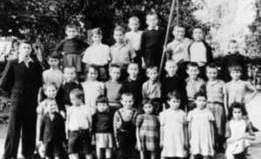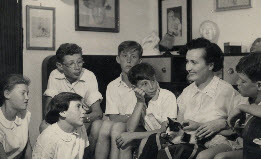about
contact
- Dr. Boaz Cohen
- boazc@wgalil.ac.il
- boaz.cohen
- Dr. Verena Buser
- verena.buser@berlin.de
- verena.buser
The Relevance of Post WW2 and Holocaust for Today´s World.
It is our claim that historians can contribute with their expertise in rehabilitating war affected children today.
„My sweet parents, Dad, Mum and a sister died in the destruction of the Krakow ghetto. In all these camps I worked very hard, went without clothes and was beaten up severely, I was also ill with many ailments, and all this when I was only a child.“ – Child’s testimony, Bergen-Belsen 1946: see papers on early children’s testimonies in the article section of this site LINK
The post war period saw the establishment of numerous institutions for survivor children. They were established either privately, by NGO’s or by the UNRRA and IRO. These shelters, homes or even, villages were the place where the caretakers and children went together through the rehabilitation process. The varied experience in these institutions can serve as tentative blueprints for today
Determining ‘the best interest of a child’ was s major issue after the war, as it is today. It was also a contentious issue. Is the best interest of a child to be left in his rescuers’ family or to be brought back to his national group? Does it entail placing him in foster care or at an institution with peers who had similar experiences? Policy makers then shifted their approaches with regards to children and took into account their heterogeneous Holocaust and war time experiences.
Family reunification after the Holocaust, in cases where some family members survived, proved to be a challenging event. It could be so traumatic that in some cases the discussion about the child’s ‘best interest’ focused on extracting that child from his family and placing him at a children’s homes with his like-experienced peers. There was not much professional support for the protagonists at the time, but the insights gained are invaluable today.
Educating children who underwent a traumatic childhood and who missed several years of schooling, was a daunting challenge. The issue was not only teaching and studying a regular school curriculum but one of helping children regain a trust in humanity, giving them a sense of belonging and building their sense of security. Educational work today can certainly benefit from the pedagogical experience gained at the time.
Getting children to relate their experiences as a therapeutic tool was not that developed after the war, much of the present psychological practices and protocols were not yet invented. Certainly, the idea of basic human right of child to be heard was not yet hatched. Yet, in the immediate post war years thousands of testimonies were collected from surviving children. The child experience was worthy of documenting and methodological questionnaire and guidelines for its collection were developed and published. Surprisingly, this is not so apparent today
Are surviving children and war orphans eligible to adoption and by whom? There were many, from the Allied forces, who wanted to adopt such children, but that entailed removing them from their people and culture. Moreover, how could one be sure in the chaotic post war situation whether they had no family members left?
Fostering, or rather, the removal of children from foster families was a thorny issue. what is the best interest of the Holocaust child survivor who found refuge in a gentile family, was it to stay there or to be returned to his people. Likewise, what was the best interest of non-Jewish Aryan looking child kidnapped from eastern Europe by the Germans and placed at a caring German foster family?
Then and today those children on the move who walk alone are most vulnerable victims of war actions. How can caretakers and stakeholders set up a protective environment where the family is missing? What are the children´s reactions to war and genocide? How can we better understand their behavior?
Children face always a high risk to become victims of sexual violence while interned in camps or during their flight. They are dependent on adults, especially those who are on the move unaccompanied. How can they be protected?
Children and teenagers who left their home countries because of mass atrocities and war actions have to learn new values and social structures of their resettlement countries. Which instruments or approaches can we take from history so that children become part of the societies of the destination countries today?

It is our claim that historians can contribute with their expertise in rehabilitating war affected children today.
Bringing Together Historians and Practitioners for the Sake of Today’s Children

Challenges of Reception of Child survivors, Then and Now

Potsdam 2020
Challenges of Children and Youth Rehabilitation

potsdam 2019
Family Reunification after the Holocaust, War and Genocide






